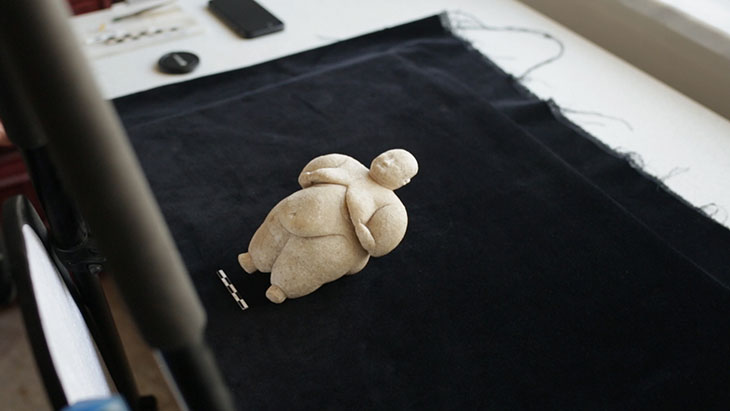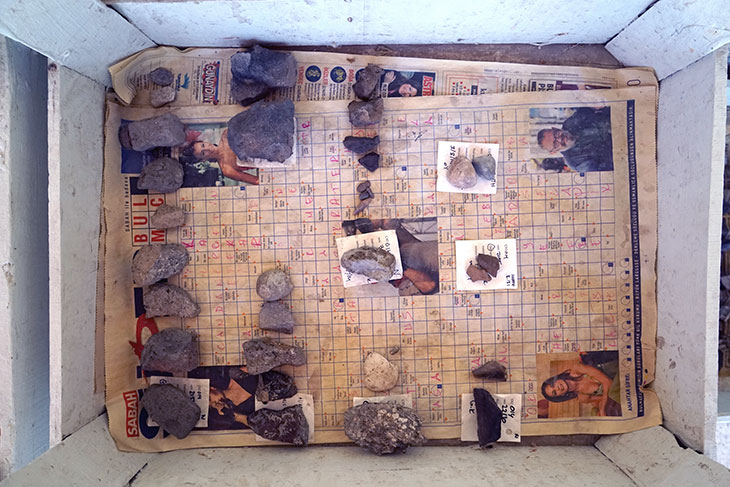Around 15 minutes into the Italian artist Rossella Biscotti’s five-channel video work The City (2018), a Venus-like figure appears. She looks to be an immaculate specimen, gleaming white marble against the black cloth on which she has been laid flat, her ovoid belly protruding into the air. Only a brief glimpse of a hand working to assess the figurine gives an inkling of her size (17 centimetres, to be exact). She lies silently, and then, after about a minute, the film cuts to an image of archaeologist’s dig site. An off-camera voice asks: ‘Have you seen any hands and feet in there?’
This is Çatalhöyük, an archaeological site dating back 9,000 years to the Neolithic period in southern Anatolia (just southeast of the Turkish city of Konya). In the summer of 2016, the discovery of this small marble woman excited the media the way attractive archaeological finds often do – first locally, and then internationally, often with a pinch of hyperbole. The female figurine may at first appear to be a symbol of fertility, but recent research at Çatalhöyük posits that she is no ‘mother goddess’. Her distinctive figure, with large breasts and thighs and sagging stomach, is believed to have represented age and wisdom – this is an elderly woman with community status. Multiple similar figurines have been found at the site.
The City (still; 2018), Rossella Biscotti, produced by Protocinema (with support from Mondriaan Fund and NEARCH). Courtesy Wilfried Lentz Gallery, Rotterdam and mor charpentier, Paris.

Biscotti had just begun her second dig season with the Çatalhöyük archaeological crew when this remarkably well-preserved figurine was being cleaned and examined. As the scholars documented, so did Biscotti, turning cameras on the site’s 150 archaeologists, researchers, and local workers. Biscotti’s two dig seasons as a member of the Çatalhöyük team evolved into The City, currently presented by Protocinema in a subterranean space in central Istanbul. The 50 minutes of collected footage offer a close examination of the intersections between ancient and contemporary communities at Çatalhöyük.
Biscotti’s work over the past decade has often centred on close archival readings related to historical events, and investigations into how archives, or collective memories, are constructed. Many of her past projects have mined political events of the 20th century: her installation at the 55th Venice Biennale documented the artist’s dream workshops with female prisoners on the island of Giudecca, taking inspiration from the dreams exchanged between Red Brigades member Nicola Valentino, who was sentenced to life in prison in 1978, and his fellow inmates. Though The City is Biscotti’s first encounter with ancient history and archaeological methodology, her presence at the dig site embodies her forensic approach to research. At Çatalhöyük, to document this community necessitated becoming a part of it.
The work begins with a series of numbers. These digits typed on to white cards represent the dig site marking system. Between muffled chatter and the sound of various tools, a conversation emerges based around location sites: clusters of stone and bone in Building 65, more deposits in 102, under the platforms and in the ovens of 44. In this community, the language is one of numbers rather than words.
The City (still; 2018), Rossella Biscotti, produced by Protocinema (with support from Mondriaan Fund and NEARCH). Courtesy Wilfried Lentz Gallery, Rotterdam and mor charpentier, Paris.

Çatalhöyük is a significant site, both for its history as an early ‘proto-city’ and for the distinctive archaeological methodology – known as ‘post-processual’ or ‘interpretive’ archaeology – undertaken there by site director Ian Hodder since 1993. The Neolithic site, comprised of two earth mounds, contains 18 successive layers of settlement that were inhabited for nearly 2,000 years. Research has shown that Çatalhöyük was home to an egalitarian society, and that those inhabiting the same homes were not necessarily biologically related. Much of The City’s screen time is devoted to excavations of the burial sites of the inhabitants, which were placed directly within their domestic structures. Hodder’s archaeological ethos somewhat echoes the community ideas unearthed at Çatalhöyük – an emphasis is placed on subjective experience and traditional archeological hierarchies are eschewed, with every team member treated as an equal. The parallels between those being excavated and those doing the excavating are evident.
Viewers are invited to watch the work, which is projected on to multiple walls, from either floor level or a raised, glassed-in platform at the head of the room – an experience that mimics Biscotti’s bird’s eye perspective during much of her time at Çatalhöyük. Midway through the film, however, the perspective lowers, and one feels a palpable rupture as cameras pan the empty dig site in complete silence. Only one day into filming the season in 2016, an attempted coup d’état in Turkey threw the future of Hodder’s research project into uncertainty. Scenes of artefact sorting are replaced with team meetings, where words like ‘danger’ ‘closure’ and ‘skeleton crew’ are dropped into conversation. Biscotti’s deft editing of this political development brings forth a new dimension of teamwork and decision-making. This hurried and anxious atmosphere fades away, replaced by quiet, broad images of the Çatalhöyük landscape – an enduring witness to centuries of societal change.
‘Rossella Biscotti – The City’ is presented by Protocinema at Sıraselviler Cad. No. 35, Beyoğlu İstanbul (at Taksim Square), until 27 October.



